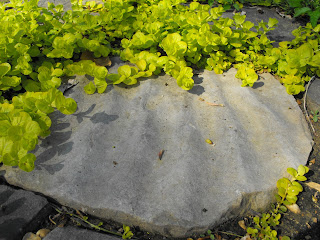
For the small garden gardener, groundcover—for example, creeping phlox, alyssum, creeping Jenny (Lysimachia nummularia), ajuga (Ajuga reptans)—may be categorized as either blessing or curse. In its former guise, groundcover may almost instantly transform small patches and beds into floral carpets or coverlets of richly-textured and colorful foliage; the arresting display is worth the effort, or lack of effort as it were.
But groundcover may also curse the soul of the gardener who planted it. It invades. It conquers. It recognizes no boundaries. I spend considerable time and energy cutting back ajuga each morning as it nightly assaults the rampart
But choices need to be made, aesthetics pleased, tastes acquired, and plans amended. With regards to amending plans, the gardener needs to dispose of remorse and shed sensitivity; the Realist gardener must take hold and show no mercy on errant plants.
I shan’t obliterate my ground cover, but I shall attempt to control it with some concentrated excisions by the trowel or, as with the larger sprawls of ajuga, the shovel. In this respect, I
In the garden beds, however, I have learned that greater control is needed. The property of 410 is limited; thus I don’t wish t
Groundcover, I conclude, becomes the perfect proxy for measuring the certitude of one’s will. One either succumbs to its beauty (which has the advantage of permitting the gardener—or ought that title be stripped and the person simply referred to as a property owner?—to do other things), or one plants and celebrates it (as I have done), only to attack it with occasional ferocity in an effort to manage it. Only with such experiences, ones that pit us against improbable foes, can one develop the courage of one's convictions.
No comments:
Post a Comment